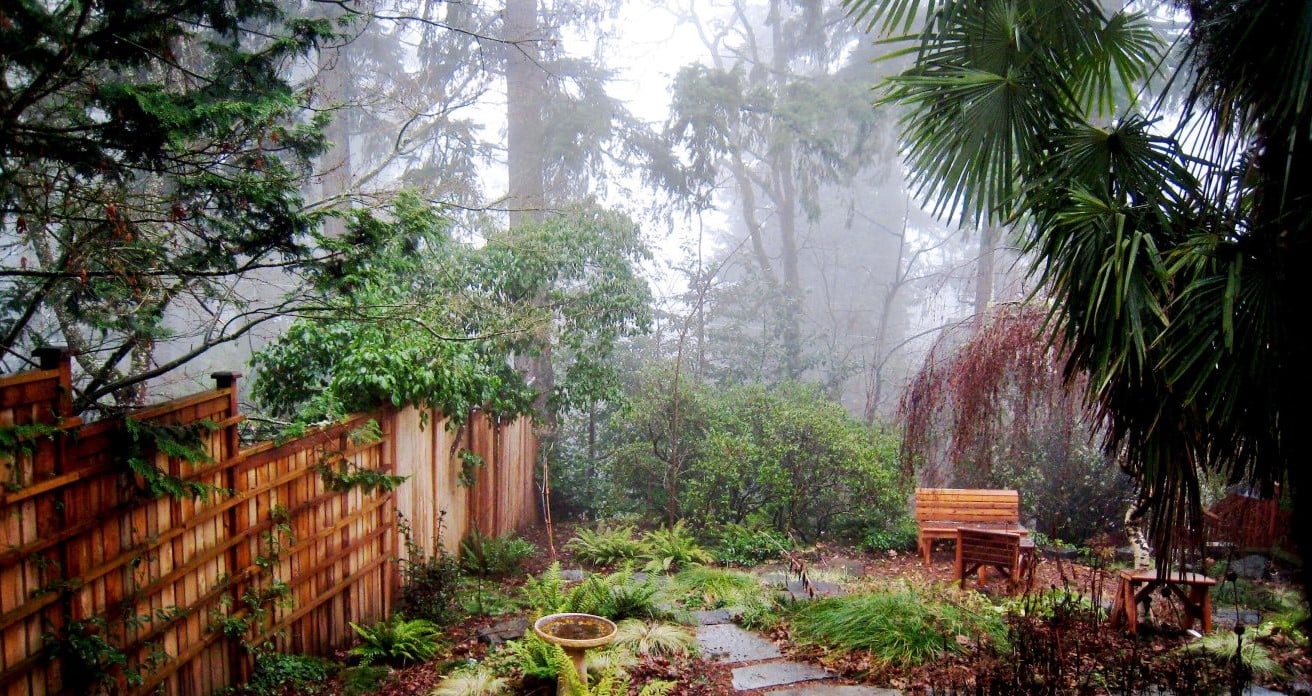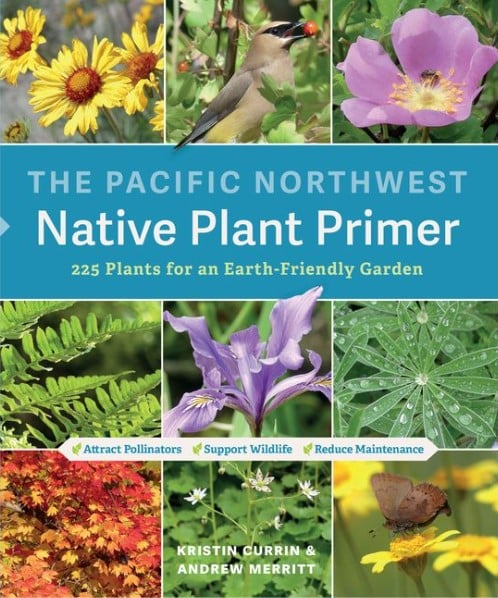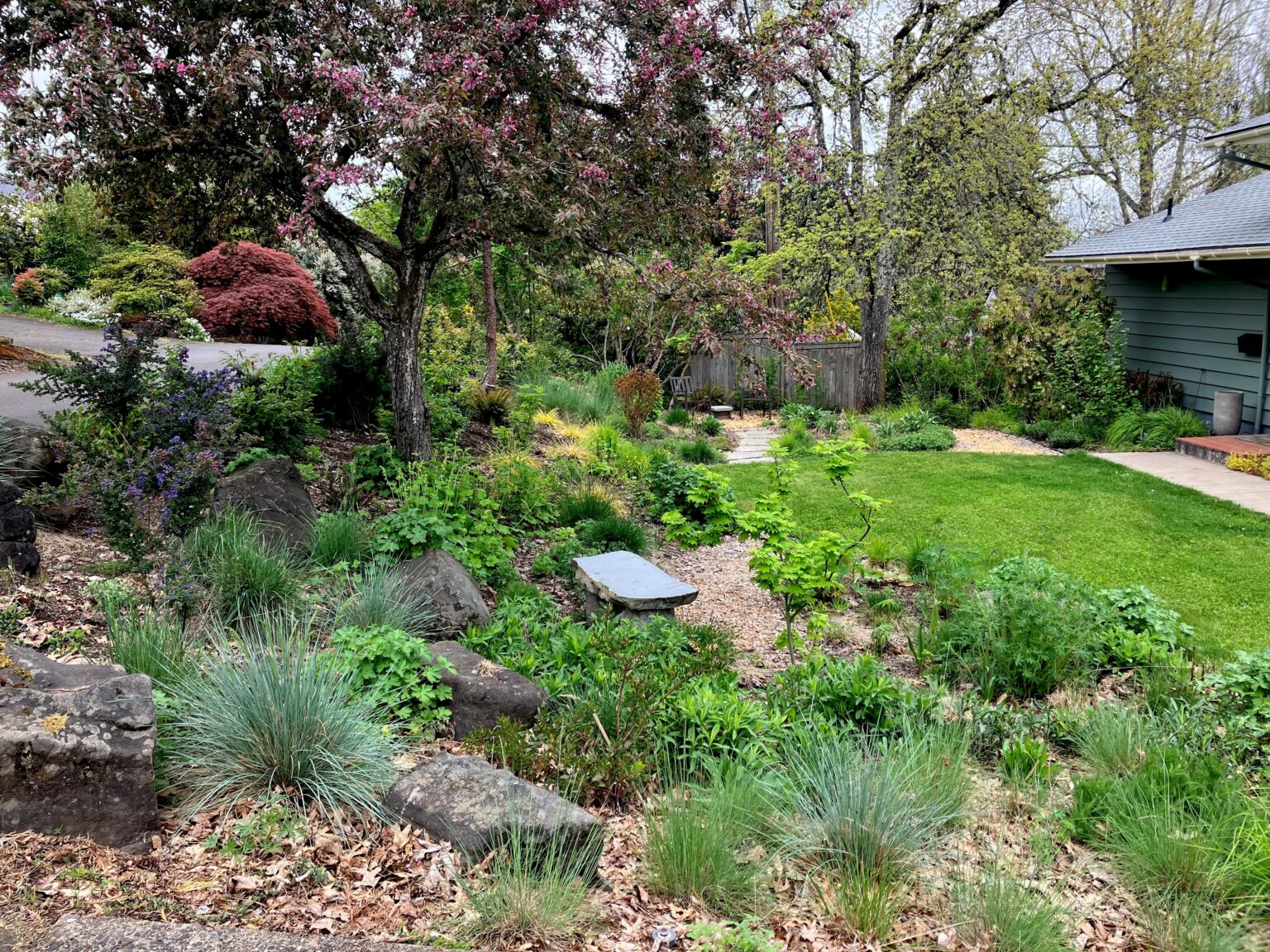
Book Review: The Pacific Northwest Native Plant Primer

Contributor
- Topics: Plants You Need
Spring 2023
255 Plants for an Earth-Friendly Garden by Kristin Currin and Andrew Merritt
“Set aside for a moment the myriad alarm bells ringing … and remember the simple joy of connecting to nature.”

Kristin Currin and Andrew Merritt’s new book about gardening with native plants is a call to action, a guide, and, importantly, a reminder of the childlike pleasure of observing flowers, insects, and birds, of connecting to nature where you live. Planting natives is rightly getting a lot of attention lately in the face of species decline. This book’s introduction roots the impulse in joy and hope rather than fear.
And what joy there is to be had when “those who live here will never be botanically bored as there are thousands of plants adapted to live and thrive in the multitude of habitats found in the region”!
Reading about orographic lift in the chapter “Pacific Northwest Habitats,” I recalled my sixth-grade outdoor school skit where I, dressed as a fluffy cloud, bumped up against a tower of my classmates who represented the Cascade Mountains.
Pulling a cord, I squeezed my costume tighter, smaller, shedding confetti of rain on the west side. I had little confetti left by the time I clambered over the “mountains” to the east side. Inland readers of Pacific Horticulture will appreciate that this book covers both plants of the wetter west side regions, as well as those from the drier, rain-shadowed east side of the Cascades.
As an urban gardener where buildings act similarly to mountains, creating dry microclimates, I too appreciate learning about plants indigenous to the rain shadow. In fact, the reputation of the Pacific Northwest as a very wet place is challenged by the authors who remind us that “the arid interior and dry summers region-wide” are home to a lot of drought-adapted plants. In the cultivation notes of many plants included in the compendium, I notice the cautions to “water only to establish” and “do not plant in sites with continual irrigation.” Pay attention to these notes and consider dedicating an unirrigated zone of your garden to a community of these tough beauties. Grouping them together will make maintenance easier as well as ensure their success.
Descriptions of the Pacific Northwest’s habitats range from the “most threatened” Oak Woodland / Oak Savanna to the “fastest growing” Disturbed areas. “Understanding your ecoregion, local habitats, and the microhabitats you create in your backyard is the first step in proper plant selection.” Making the time to embrace the context of where you garden sets a strong foundation for success.
In the chapter titled “Beauty in Biodiversity,” the authors expand this thread of context and interconnection with the call to “see our backyards as part of the local ecology and seek to harbor life other than our own.” An expanded sense of beauty awaits when you plant not only the blooms and foliage of your personal preference, but also for those who “rest, nest, feed, and breed” in your garden, for those who animate the scene with life. If you’ve heard the studies that show how a yard planted with 70 percent locally appropriate native plants is essential for wildlife to thrive, you may be wondering where to start. I suggest beginning with this book! You’ll learn how to bolster natural food webs by providing for birds and native pollinators. Your garden can be a place to take “a powerful and hopeful step … toward ensuring a better future for all.”
Moving beyond feel-good reasons for why to plant natives, the book continues with an excellent chapter on plant selection and cultivation. I appreciate the realistic notes on maintenance. Unlike other material that claims natives are always easy, these authors come from lived experience when they say that “gardeners who expect all natives to be invincible are setting themselves up for failure.” Luckily, with their guidance on sourcing plants, site preparation, planting and mulching, establishing and watering, your garden will thrive. A little forethought and regular doses of love and care is really all it takes.

The bulk of the book highlights the wildflower, grass, fern, shrub, and tree species you’ll want to use in your native habitat garden. I was pleased to learn new-to-me wildlife associations of old favorites, like the fact that not only does Oregon wood-sorrel (Oxalis oregana) attract pollinators, but birds and small mammals also eat its seeds. Since childhood, I’ve enjoyed nibbling wood-sorrel leaves on my forest romps, but I’d never thought of the small creatures who depend on the plant’s nourishment.
Each one of the 255 plants in the book includes this kind of unique note on wildlife value, along with information on habitat/range, seasonal interest, cultivation, and a lively description that roots the species in the garden setting. Even if you don’t love to read, the photos of each plant, and throughout every page of the book, will pull you in and open your eyes to the diversity of life in our region. It’s truly a coffee-table-appropriate collection of photography!
I’ve lived in Oregon since birth, admiring our plant life all these years, and yet, I’ve learned some new species from the Native Plant Primer. Are you familiar with Western snakeroot (Ageratina occidentalis)? Its fuzzy pink flowers would look fantastic in the garden. The drought-tolerant fragile fern (Cystopteris fragilis) sounds like a real charmer I’d love to meet. Of course, finding nursery sources for native plants can be a challenge. Asking retail suppliers and your nursery contacts for hard-to-find species is a great way to encourage more diversity of natives to be available for everyone.
The only piece of information I would love to see added to the plant descriptions is a note about companion species. Some photos depict the beauty of multiple plants growing together, like yarrow (Achillea millefolium), Oregon sunshine (Eriophyllum lanatum), and ookow (Dichelostemma congesta), a fantastic combo I’ve had luck with in the garden, but most are individuals. Spending any time observing plants in nature quickly teaches you that plants grow in communities, not isolation. The gardener as artist has the opportunity to experiment and discover who is happy to mingle together.
The book concludes with a section on “Plants for Specific Purposes.” Here, you can find useful lists for different themes like hummingbird plants, aromatic plants, or the garden essential: evergreen plants. Just today I referred to the list of plants that provide fruits for birds while working on a mixed hedge design, and was inspired to include red-flowering currant (Ribes sanguineum). I know I’ll be checking back in here often to jog my memory and help me include at least 70 percent natives in the gardens I help create. I hope you, too, can tap into this generous contribution to our region’s gardening culture and bring more life to your yard.
Review by: Leslie Davis, a garden designer and book lover in Eugene, Oregon
Follow along at www.wholegardensnw.com









Responses